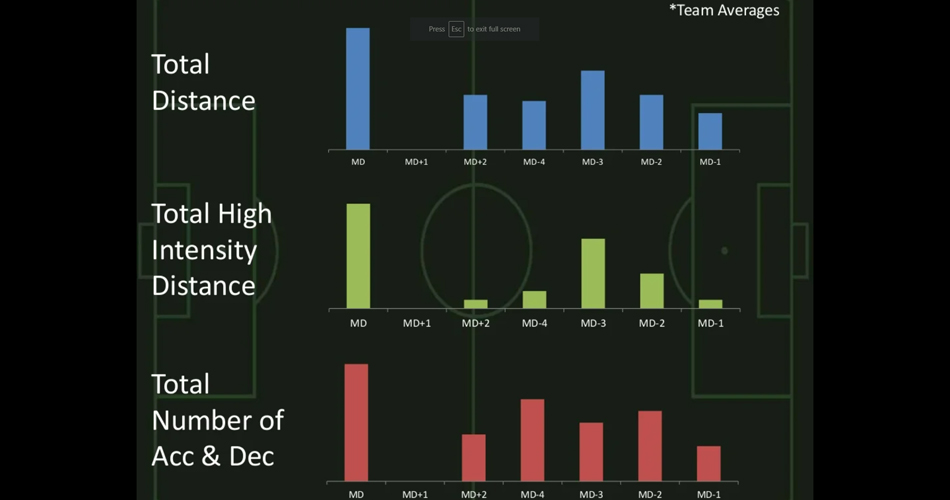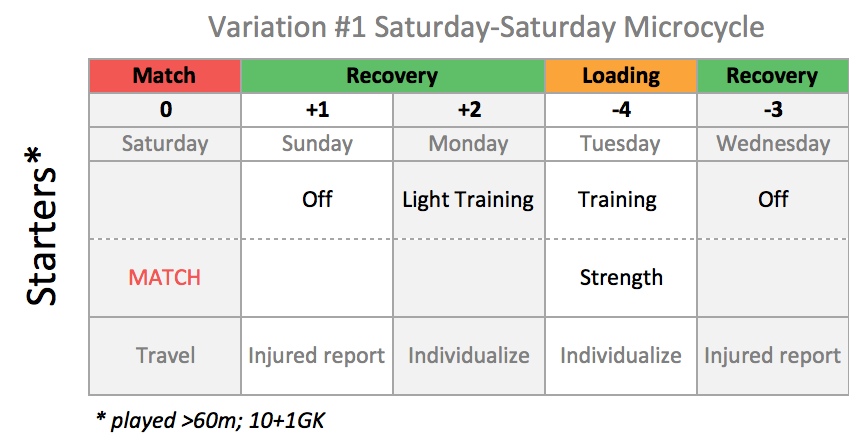Planning the In-Season Microcycle in Soccer Part 4: Thoughts on Recovery “Mini-Block”
Previous parts:
- Planning the in-season microcycle in soccer – Part 1: Complexity
- Planning the in-season microcycle in soccer – Part 2: Mark Williams Case Study
- Planning the in-season microcycle in soccer – Part 3: Mick McDermott Case Study
I will use this installment to share some thought on “Recovery mini-block”, which is one of four parts of microcycle: recovery, load, taper and game. I will focus on starters (see concept of functional groups in previous installments: starters, bench, reserves) and focus on one game per week, although this discussion can expand to two games per week as well.
On the following picture there are two most common variations of recovery mini-block: variation 1 where we have day-off and active-recovery and variation 2 where we have active recovery and then day off. There could be two days off (maybe after a phase with a lot of games) or two active recoveries (or easy sessions) when we have two games per week.
It is important to note that the peak in fatigue markers (blood markers, subjective indicators and performance markers as well) occur on 2nd day after a game, or 24-48h after and returns to normal approx. 72h after (see more HERE, HERE, HERE and HERE). This can vary between the sports (e.g. basketball vs. soccer), but from the links above you can see that there is similarity between soccer and rugby in that regard.
Speaking from practice, players complain more on the 2nd day after the game than on 1st day after a game. That’s probably the first thing I have learned since started working in soccer. This is probably because of the delay in fatigue markers and DOMS.
Taking out the logistics, the question is what variation is better from biological standpoint. By “better” I consider two things (and they are somewhat opposite, but still complementary): recovery and adaptation.
From recovery standpoint, is it better to do active recovery on the second day, since that’s the time fatigue markers basically peak. Or, to do it the day after the game. The question is how is the timing of day-off and recovery session affecting recovery during the week? Which one is better in returning markers/indicators to the baseline the fastest? Not sure we have research to back anything up.
From adaptation standpoint, will recovery session on the second day (by recovery I refer to active recovery, stretching, cold baths, massage) blunt the adaptation signaling? Should we allow for some inflammation the first 24h to reap the benefits of the game load? Basically, the question is, how is timing of day-off and recovery session affecting the long term (i.e. in-season) adaptation to training load?
As always more questions than answers. I am not sure what variation to prefer, taking into account ‘logistics’ along with biology. We also need to take into consideration the affect of recovery mini-block on loading mini-block.
Not sure why, but I might prefer variation #1 (day-off and then recovery), but I don’t have any data to back up my gut feeling. First off, giving a day off the next day after a game might give some time to cool the heads (probably managers more than players) and let the game impressions sink. Players might also prefer to spend more time with family, especially if the return trip is 2-3AM, so they can sleep long and don’t need to show up at the facility. The active recovery (plus meetings) can provide an easy way in into the loading phase (compare it to coming to loading phase right of the day-off: in my experience the players might be a bit sluggish). The timing of the recovery is also done when we have peaks in fatigue markers.
On the flip side, we might have some other aspect that might affect the performance. If the day-off is on sunday (game saturday), we might have players going out and drinking, and we know how detrimental alcohol is to performance/recovery. Hence, we might give them morning session, so they take it easy. Again, it depends on the culture in the team.
One last thought is: why don’t we ask the players? If we give them more engagement in decision making maybe we can get more buy-in. Plus they feel more in ‘control’ which can decrease the burnout probability. Maybe it is up to their preference?
What about strength training?
When it comes to ‘recovery mini-block’ and especially the ‘active recovery’ (or easy day) we might do (on the day 1 or 2) there is also a question of doing strength training.
Can some low intensity, slow contractions (i.e. longer TUT), medium volume workout help with tissue recovery? Or aid additional stress and screw up recovery process?
Some teams like to do upper body lifting on those days. Again the question is on what day is this being done and how it is that affecting the recovery and adaptation?
Players, like all men and those who feel like that, like hitting the ‘beach muscles’ anytime. Doing those when they are a bit ‘down’ might reduce the over-emphasis of beach work and thus avoid unnecessary upper body hypertrophy.
When it comes to lower body, I am not sure the the high intensity, nor high volume workout is a great decision. If something is being done for the lower body, maybe something more aimed at “mobility”, 2-3 set and higher reps, slow velocity to potentially stimulate tendons and connective tissue healing. I wonder would this provide for much needed adaptation or be detrimental to recovery.
One more thought to consider is injuries. If the recovery period is completely passive, some injuries might go under the radar. Sometime we used to do short strides (~50-60m @100-100% MAS or just go with the flow) for 3×5 with some abs/pushups in between. Why? Because you basically also ‘test’ the athlete for potential troubles. You can’t do this with jogging because ROM is very small. Some athlete like doing those more than 20min jogging.
So taking this principle into consideration , some strength work might be a way to ‘test’ for potential issues that went unnoticed.












Responses